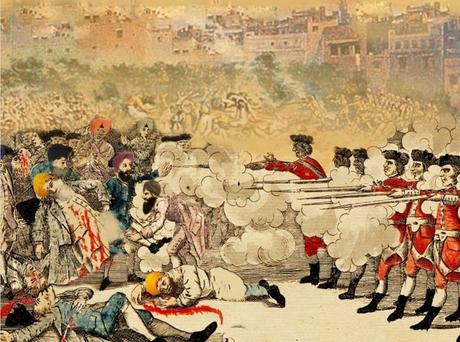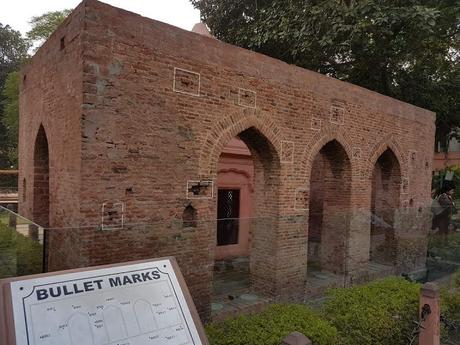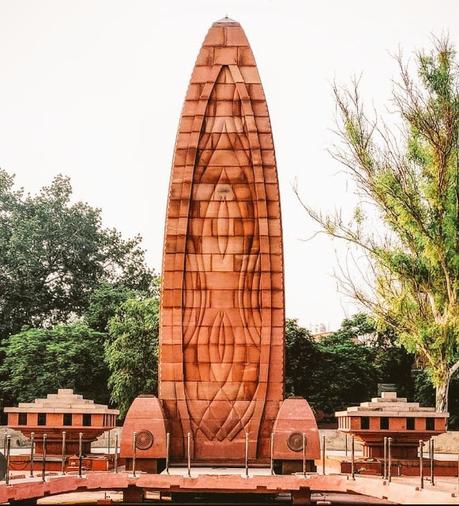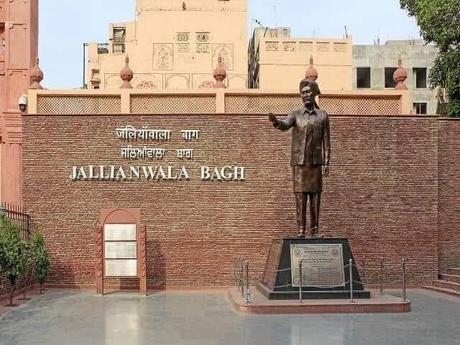Often Indian freedom struggle gets described in one pithy statement- Gandhi got us freedom without shedding blood !~ how much away from truth, and why the sacrifices and blood of martyrs was so deliberately buried under ? – how can the Nation forget the bloodshed on that day in Apr 1919 ??- People have died on battlefields, not on meeting platforms !
Amritsar historically known as Rāmdāspur is in the Majha region of the Punjab.The Bhagwan Valmiki Tirath Sthal situated at Amritsar is believed to be the Ashram site of Maharishi Valmiki, the writer of Ramayana. This was also the place of Ramtirth ashram where Lava & Kusha were born.There is also a tree here that marks the place where the ritual horse from Ashvamedha Yagna of Lord Rama was captured by Lava Kusha. Guru Ram Das, the fourth Sikh guru is credited with founding the holy city of Amritsar in the Sikh tradition.The town grew to become the city of Amritsar, and the pool area grew into a temple complex after his son built the gurdwara Harmandir Sahib, and installed the scripture of Sikhism inside the new temple in 1604.
Do you follow Politics and Indian Elections – the Amritsar East Assembly Constituency for Punjab Legislative Assembly was won by Cricketer Navjot Singh Sidhu in 2017 representing Congress, the same seat was earlier held by MrsNavjot Kaur Sidhu, representing Bharatiya Janata Party.Amritsar North Assembly Constituency is now held by Sunil Dutti, Indian National Congress.In 1952 elections – Amritsar City North had an electorate of 50136 but polled votes were only 38.75% - Satya Pal of INC secured 11129 votes defeating Joginder Singh who got 4043 votes. Why are we reading this ?

Sadly, Amritsar is also the place when on 13th April 1919 hundreds of innocents were massacred by the British – theJallianwala Bagh massacre, involving the killings of hundreds of Indian civilians on the orders of Reginald Edward Harry Dyer.No event within living memory, can ever make so deep and painful an impression on the Indian subjects than the history or the very thought of massacre of innocents at Amritsar.The ruthless execution has no parallels and this Nation suffered economically more severely from the World war despite no direct participation. It was the cruel General Dyer who had earlier writtena spirited account of his campaign against some nomad tribes on the frontier of South- East Persia and Baluchistan in 1916.
 The gory
massacre was to occur and make Baisakhi day April 13, 1919, a tragic day on
that day, local residents in Amritsar decided to hold a meetingto discuss and protest against the
confinement of Satya Pal and Saifuddin
Kitchlew, two leaders fighting for Independence (did we ever read about
them in our school books ?). People were also
protesting implementation of the Rowlatt Act, which armed the British
government with powers to detain any person without trial. It was no violent
crowd – it had a mix of men, women and children,gathered in a park called the
JallianwalaBagh, walled on all sides havinga few small gates.It was to be a
peaceful meeting of peasants and people and included pilgrims visiting the
famous Golden temple.
For one
man it was not a peaceful assembly - Brigadier-General Reginald E.H. Dyer
entertained to self,thoughts ofa major insurrection and thus he banned all
meetings. On hearing that thousands had gathered in the park,Dyer went with fifty riflemen to a raised
bank and ordered them to shoot at the crowd. Dyer continued the firing for
about ten minutes, till the ammunition supply was almost exhausted; Dyer stated
that 1,650 rounds had been fired, a number which seems to have been derived by
counting empty cartridge cases picked up by the troops. Dyer was removed from
duty and forced to retire. He became a celebrated hero in Britain among people
with connections to the British Raj.
For those of us with little knowledge of history – the names are
confusing - there were two of
them.Michael O'Dwyer, the British
Lieutenant-Governor of Punjab who approved the action and Brigadier-General
Reginald E.H. Dyer who executed the mindless massacre.
The gory
massacre was to occur and make Baisakhi day April 13, 1919, a tragic day on
that day, local residents in Amritsar decided to hold a meetingto discuss and protest against the
confinement of Satya Pal and Saifuddin
Kitchlew, two leaders fighting for Independence (did we ever read about
them in our school books ?). People were also
protesting implementation of the Rowlatt Act, which armed the British
government with powers to detain any person without trial. It was no violent
crowd – it had a mix of men, women and children,gathered in a park called the
JallianwalaBagh, walled on all sides havinga few small gates.It was to be a
peaceful meeting of peasants and people and included pilgrims visiting the
famous Golden temple.
For one
man it was not a peaceful assembly - Brigadier-General Reginald E.H. Dyer
entertained to self,thoughts ofa major insurrection and thus he banned all
meetings. On hearing that thousands had gathered in the park,Dyer went with fifty riflemen to a raised
bank and ordered them to shoot at the crowd. Dyer continued the firing for
about ten minutes, till the ammunition supply was almost exhausted; Dyer stated
that 1,650 rounds had been fired, a number which seems to have been derived by
counting empty cartridge cases picked up by the troops. Dyer was removed from
duty and forced to retire. He became a celebrated hero in Britain among people
with connections to the British Raj.
For those of us with little knowledge of history – the names are
confusing - there were two of
them.Michael O'Dwyer, the British
Lieutenant-Governor of Punjab who approved the action and Brigadier-General
Reginald E.H. Dyer who executed the mindless massacre.
 As
India remembers 1,500 people who laid down their lives 101 years ago at
Jallianwala Bagh in Punjab on Baisakhi day, the pages of history have somehow
missed an important chapter on why the gathering were organised in the first
place. They gathering was to protest against the arrest of
two tall political leaders of Punjab - Saifuddin
Kitchlew and Satyapal.They had not only shaken the foundation of the British colonial rule
in India but amplified the threat by strengthening the Hindu-Muslim bonhomie.
It was in 1919 that India had emerged strongly in response to repeated attempts
by the Britishers to divide and rule the country particularly on the basis of
religion.
As we
read about Mohandas Gandhi and Jawaharlal Nehru, the latter writing letter to
his daughter from prison and more – more freedom fighters were obliterated by
the tricky historians who painted the version of their choice.
Satyapal
(885) was a physician and political
leader in Punjab, British India, who was arrested along with Saifuddin Kitchlew
in Apr 1919 few days before the Jallianwala Bagh massacre.Satyapal was educated at Cambridge when he
was known to Nehru.In 1915, during
First WW he received a temporary King's Commission as a lieutenant in the
Indian Medical Service, serving with distinction.Sooner he was to exit in 1916 and spearheaded
themovement of non-cooperation against
the British rule.He was married and was
having a successful practice in the old part
of the city of Amritsar.
On the
orders of Governof of Punjab, Michael
O’Dwyer the CID had kept close surveillance on Kitchlew and Satypal from
mid-March 1919. Again, following the orders of O'Dwyer, they were summoned to
Miles Irving, the Deputy Commissioner's house in the Civil Lines and were ordered to leave Amritsar and were
taken away under military escort.As the
news of the arrest spread, supporters began to gather near Irving's home and
what initially appeared a peaceful attempt to make enquiries ended up in a
violent clash. On 13 April 1919, protesting
over the arrest, a meeting was called to take place at Jallianwala Bagh.
Thus both
of them were not at the scene of Jallianwala Bagh at the time of massacre of
innocents – months later in June 1919, at the trial of the 'Amritsar conspiracy
case at Lahore', Satyapal was convicted with 14 others and sentenced to two
years imprisonment.
PS
:1) Sir Sidney Arthur Taylor Rowlatt,
KCSI was an English lawyer and judge, best remembered for his controversial
presidency of the Rowlatt Committee, a sedition committee appointed in 1918 by
the British Indian Government to evaluate the links between political terrorism
in India, especially Bengal and the Punjab, and the German government and the
Bolsheviks in Russia. The committee gave rise to the Rowlatt Act, an extension
of the Defence of India Act 1915
2) the mindless
butcher of Amritsar, General Dyer was removed from command and exiled to
Britain not with fine butwith a gift of
26,000 pounds,a huge sum in those days.
He died in 1927 after suffering a series of heart strokes.The gift that he got - of £26,000 sterling,
emerged from a fund set up on his behalf by the Morning Post, a conservative,
pro-imperialist newspaper, which later merged with the Daily Telegraph.
3) Sir Michael Francis O'Dwyer GCIE KCSI was
Lieutenant Governor of the Punjab in India from 1912 until 1919. O'Dwyer
endorsed General Reginald Dyer's action regarding the Amritsar massacre and
termed it a "correct action". In 1940, aged 75, he was assassinated
by Udham Singh.At the entrance of
Jallianwala massacre memorial is a statue of Udham Singh.
As
India remembers 1,500 people who laid down their lives 101 years ago at
Jallianwala Bagh in Punjab on Baisakhi day, the pages of history have somehow
missed an important chapter on why the gathering were organised in the first
place. They gathering was to protest against the arrest of
two tall political leaders of Punjab - Saifuddin
Kitchlew and Satyapal.They had not only shaken the foundation of the British colonial rule
in India but amplified the threat by strengthening the Hindu-Muslim bonhomie.
It was in 1919 that India had emerged strongly in response to repeated attempts
by the Britishers to divide and rule the country particularly on the basis of
religion.
As we
read about Mohandas Gandhi and Jawaharlal Nehru, the latter writing letter to
his daughter from prison and more – more freedom fighters were obliterated by
the tricky historians who painted the version of their choice.
Satyapal
(885) was a physician and political
leader in Punjab, British India, who was arrested along with Saifuddin Kitchlew
in Apr 1919 few days before the Jallianwala Bagh massacre.Satyapal was educated at Cambridge when he
was known to Nehru.In 1915, during
First WW he received a temporary King's Commission as a lieutenant in the
Indian Medical Service, serving with distinction.Sooner he was to exit in 1916 and spearheaded
themovement of non-cooperation against
the British rule.He was married and was
having a successful practice in the old part
of the city of Amritsar.
On the
orders of Governof of Punjab, Michael
O’Dwyer the CID had kept close surveillance on Kitchlew and Satypal from
mid-March 1919. Again, following the orders of O'Dwyer, they were summoned to
Miles Irving, the Deputy Commissioner's house in the Civil Lines and were ordered to leave Amritsar and were
taken away under military escort.As the
news of the arrest spread, supporters began to gather near Irving's home and
what initially appeared a peaceful attempt to make enquiries ended up in a
violent clash. On 13 April 1919, protesting
over the arrest, a meeting was called to take place at Jallianwala Bagh.
Thus both
of them were not at the scene of Jallianwala Bagh at the time of massacre of
innocents – months later in June 1919, at the trial of the 'Amritsar conspiracy
case at Lahore', Satyapal was convicted with 14 others and sentenced to two
years imprisonment.
PS
:1) Sir Sidney Arthur Taylor Rowlatt,
KCSI was an English lawyer and judge, best remembered for his controversial
presidency of the Rowlatt Committee, a sedition committee appointed in 1918 by
the British Indian Government to evaluate the links between political terrorism
in India, especially Bengal and the Punjab, and the German government and the
Bolsheviks in Russia. The committee gave rise to the Rowlatt Act, an extension
of the Defence of India Act 1915
2) the mindless
butcher of Amritsar, General Dyer was removed from command and exiled to
Britain not with fine butwith a gift of
26,000 pounds,a huge sum in those days.
He died in 1927 after suffering a series of heart strokes.The gift that he got - of £26,000 sterling,
emerged from a fund set up on his behalf by the Morning Post, a conservative,
pro-imperialist newspaper, which later merged with the Daily Telegraph.
3) Sir Michael Francis O'Dwyer GCIE KCSI was
Lieutenant Governor of the Punjab in India from 1912 until 1919. O'Dwyer
endorsed General Reginald Dyer's action regarding the Amritsar massacre and
termed it a "correct action". In 1940, aged 75, he was assassinated
by Udham Singh.At the entrance of
Jallianwala massacre memorial is a statue of Udham Singh.
 4)the men whose arrest sparked that violence –
Satyapal, rejoined Indian Medical Service following outbreak of Second World
War.After
Indian independence, he contested Punjab
Vidhan Sabha elections in 1952 at Amritsar City
North constituency and won comfortably.
5) the other
person - Kitchlew belonged to a upper class
Kashmiri business family that migrated to Punjab in the 19th century. He had
opted to attain his post doctoral degree and was believed to be close to
Jawaharlal Nehru. After being released from the prison, Kitchlew stayed
attached to his roots in India had to shift to Delhi during partition and faded
away.
On 15th
Aug 1947 India obtained freedom without shedding blood – Gandhi was hailed as
Father of the Nation and the leader of Indian National Congress Jawaharlal
Nehru became the first Prime Minister of India – and we have read lot of
history in our schools and colleges.
Jai Hind
With regards
to all those martyrs whose sacrifices have given us this freedom.
-
S. Sampathkumar.
-
14th Apr 2020.
4)the men whose arrest sparked that violence –
Satyapal, rejoined Indian Medical Service following outbreak of Second World
War.After
Indian independence, he contested Punjab
Vidhan Sabha elections in 1952 at Amritsar City
North constituency and won comfortably.
5) the other
person - Kitchlew belonged to a upper class
Kashmiri business family that migrated to Punjab in the 19th century. He had
opted to attain his post doctoral degree and was believed to be close to
Jawaharlal Nehru. After being released from the prison, Kitchlew stayed
attached to his roots in India had to shift to Delhi during partition and faded
away.
On 15th
Aug 1947 India obtained freedom without shedding blood – Gandhi was hailed as
Father of the Nation and the leader of Indian National Congress Jawaharlal
Nehru became the first Prime Minister of India – and we have read lot of
history in our schools and colleges.
Jai Hind
With regards
to all those martyrs whose sacrifices have given us this freedom.
-
S. Sampathkumar.
-
14th Apr 2020.

